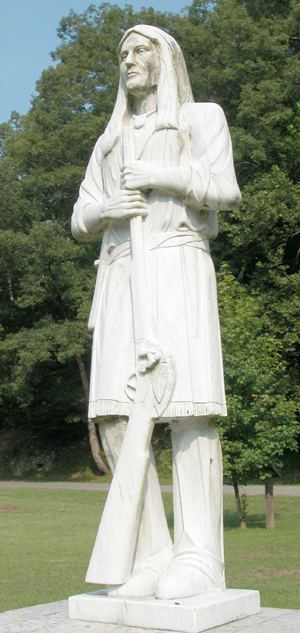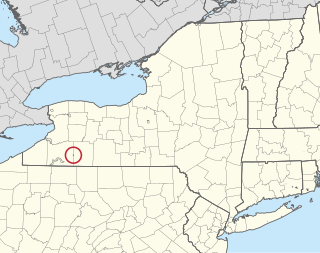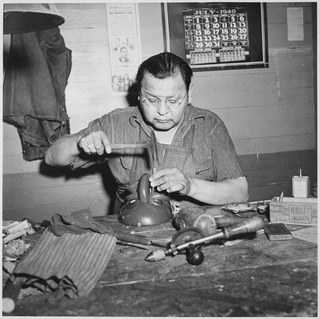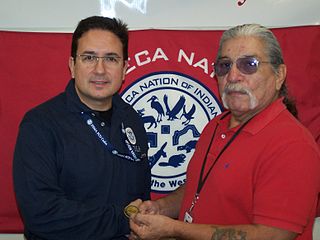See also
- Corn planter, a planter (farm implement) for maize (corn)
- All pages with titles beginning with Cornplanter
Cornplanter may refer to:

Oil City is a city in Venango County, Pennsylvania, United States. Known for its prominence in the initial exploration and development of the petroleum industry, it is located at a bend in the Allegheny River at the mouth of Oil Creek.

Allegany Reservation is a Seneca Nation of Indians reservation in Cattaraugus County, New York, USA. In the 2000 census, 58 percent of the population within the reservation boundaries were Native Americans. Some 42% were European Americans; they occupy properties under leases from the Seneca Nation, a federally recognized tribe. The population outside of the rented towns was 1,020 at the 2010 census. The reservation's Native American residents are primarily members of the Seneca, but a smaller number of Cayuga, another Iroquois nation, also reside there, and at least one family is known to have descended from the Neutral Nation. Prior to the 17th century, this area was occupied by the Iroquoian-speaking Wenrohronon and Eriehronon. The more powerful Seneca eliminated these competing groups during the Beaver Wars beginning in 1638, as the Iroquois Confederacy sought to control the lucrative fur trade with the French and Dutch colonists.

Logan the Orator was a Cayuga orator and war leader born of one of the Six Nations of the Iroquois Confederacy. After his 1760s move to the Ohio Country, he became affiliated with the Mingo, a tribe formed from Seneca, Cayuga, Lenape and other remnant peoples. He took revenge for family members killed by Virginian Long knives in 1774 in what is known as the Yellow Creek Massacre. His actions against settlers on the frontier helped spark Dunmore's War later that year.

Oil Springs Reservation or Oil Spring Reservation is an Indian reservation of the federally recognized Seneca Nation that is located in southwestern New York, United States. As of the 2010 census, the Indian reservation had one resident; in 2005 no tribal members had lived on the property. The reservation covers about one square mile (2.6 km2), divided between the present-day counties of Allegany and Cattaraugus. The reservation is northwest of the village of Cuba. It is bordered by the Town of Cuba and the Town of Ischua.

The Holland Land Company was an unincorporated syndicate of thirteen Dutch investors from Amsterdam, headquartered in Philadelphia, who purchased large tracts of American land for development and speculation. Their primary purchase was that of the western two-thirds of the Phelps and Gorham Purchase in 1792 and 1793, an area that afterward was known as the Holland Purchase. Additional lands were purchased in northwest Pennsylvania. Aliens were forbidden from owning land within New York State, except by special acts of the New York State Legislature, so investors placed their funds in the hands of certain trustees who bought the land in central and western New York State. The syndicate hoped to sell the land rapidly at a great profit. Instead, for many years they were forced to make further investments in their purchase; surveying it, building roads, digging canals, to make it more attractive to settlers. They influenced state policy in New York to allow foreign ownership of the land, avoid new taxes, and promote the construction of the Erie Canal and government roads on the company lands. They supported Governor Dewitt Clinton's faction in the state government to achieve these goals. The company finished selling its New York lands in 1839 and its Pennsylvania lands in 1849, and the company was liquidated in 1858.

John Abeel III known as Gaiänt'wakê or Kaiiontwa'kon in the Seneca language and thus generally known as Cornplanter, was a Dutch-Seneca chief warrior and diplomat of the Seneca people. As a war chief, Cornplanter fought in the American Revolutionary War on the side of the British. After the war Cornplanter led negotiations with the United States and was a signatory of the Treaty of Fort Stanwix (1784), the Treaty of Canandaigua (1794), and other treaties. He helped ensure Seneca neutrality during the Northwest Indian War.

French Creek is a tributary of the Allegheny River in northwestern Pennsylvania and western New York in the United States.
There are four treaties of Buffalo Creek, named for the Buffalo River in New York. The Second Treaty of Buffalo Creek, also known as the Treaty with the New York Indians, 1838, was signed on January 15, 1838 between the Seneca Nation, Mohawk nation, Cayuga nation, Oneida Indian Nation, Onondaga (tribe), Tuscarora (tribe) and the United States. It covered land sales of tribal reservations under the U.S. Indian Removal program, by which they planned to move most eastern tribes to Kansas Territory west of the Mississippi River.

Tah-won-ne-ahs or Thaonawyuthe, known in English as either Chainbreaker to his own people or Governor Blacksnake to the European settlers, was a Seneca war chief and sachem. Along with other Iroquois war chiefs, he led warriors to fight on the side of the British during the American Revolutionary War from 1777 to 1783. He was prominent for his role at the Battle of Oriskany, in which the Loyalist and allied forces ambushed a force of Patriots. After the war, he supported his maternal uncle, Handsome Lake, as a prominent religious leader. Chainbreaker allied with the United States in the War of 1812 and later encouraged some accommodation to European-American settlers, allowing missionaries and teachers on the Seneca reservation.
Cornplanter State Forest is a Pennsylvania State Forest in Pennsylvania Bureau of Forestry District #14. The main office is located in North Warren in Warren County, Pennsylvania, in the United States. It is named for Chief Cornplanter of the Seneca Nation, one of the tribes of the Iroquois Confederacy.

The Kinzua Dam, on the Allegheny River in Warren County, Pennsylvania, is one of the largest dams in the United States east of the Mississippi River. It is located within the Allegheny National Forest.
Buffalo Creek is a tributary of the Allegheny River in Armstrong and Butler counties, Pennsylvania in the United States.

Shikellamy, also spelled Shickellamy and also known as Swatana, was an Oneida chief and overseer for the Iroquois confederacy. In his position as chief and overseer, Shikellamy served as a supervisor for the Six Nations, overseeing the Shawnee and Lenape tribes in central Pennsylvania along the Susquehanna River and protecting the southern border of the Iroquois Confederacy. While his birth date is not known, his first recorded historical appearance was in Philadelphia in 1728. In 1728 he was living in a Shawnee village in Pennsylvania near modern Milton, and moved in 1742 to the village of Shamokin, modern day Sunbury, at the confluence of the West and North Branches of the Susquehanna. Shikellamy was an important figure in the early history of the Province of Pennsylvania and served as a go-between for the colonial government in Philadelphia and the Iroquois chiefs in Onondaga. He welcomed Conrad Weiser to Shamokin and served as Weiser's guide on his journeys into the frontier of Pennsylvania and New York.

The French Creek Council serves Boy Scouts in six counties in northwestern Pennsylvania and one township in Ohio. The council was organized in 1972 from a merger of the former Washington Trail Council of Erie, Custaloga Council of Sharon and Colonel Drake Council of Oil City, Pennsylvania. It has headquarters in Erie, Pennsylvania.

Jesse J. Cornplanter was an actor, artist, author, craftsman, Seneca Faithkeeper and World War I decorated veteran. The last male descendant of Cornplanter, an important 18th-century Haudenosaunee leader and war chief, his Seneca name was Hayonhwonhish. He illustrated several books about Seneca and Iroquois life. Jesse Cornplanter wrote and illustrated Legends of the Longhouse (1938), which records many Iroquois traditional stories. Cornplanter was also the first Native American to play a lead in a feature film titled Hiawatha, which was released in 1913 and a year before the notable Western The Squaw Man.

The Seneca Nation of Indians is a federally recognized Seneca tribe based in western New York. They are one of three federally recognized Seneca entities in the United States, the others being the Tonawanda Band of Seneca and the Seneca-Cayuga Nation of Oklahoma. Some Seneca also live with other Iroquois peoples on the Six Nations of the Grand River in Ontario.
The Treaty of Big Tree was a formal treaty signed in 1797 between the Seneca Nation and the United States, in which the Seneca relinquished their rights to nearly all of their traditional homeland in New York State—nearly 3.5 million acres. In the 1788 Phelps and Gorham Purchase, the Haudenosaunee (Iroquois) had previously sold rights to their land between Seneca Lake and the Genesee River. The Treaty of Big Tree signed away their rights to all their territory west of the Genesee River except 12 small tracts of land for $100,000 and other considerations. The money was not paid directly to the tribe, but was to be invested in shares of the Bank of the United States, and to be paid out to the Senecas in annual earnings of up to six percent, or $6,000 a year, on the bank stock.

Edward Cornplanter or So-son-do-wa (1856–1918) was a chief of the Seneca people of the Iroquois Nation (Haudenosaunee) and a leading exponent of the Code of Handsome Lake.
Carrie Cornplanter (1887–1918) was a Native American artist of the Seneca tribe.
The Cornplanter Tract or Cornplanter Indian Reservation is a plot of land in Warren County, Pennsylvania that was administered by the Seneca tribe. The tract consisted of 1,500 acres (610 ha) along the Allegheny River.